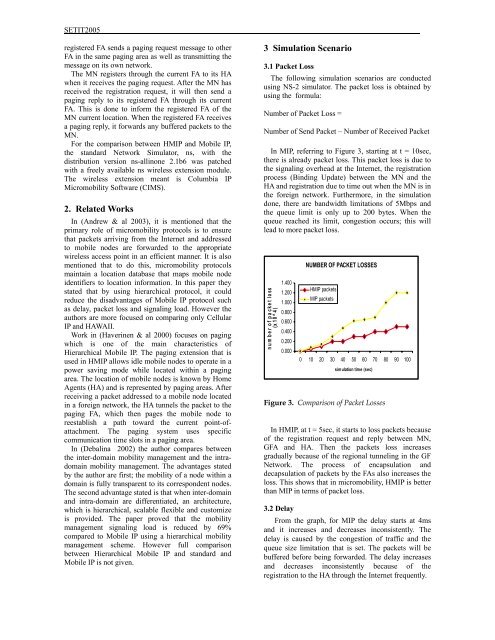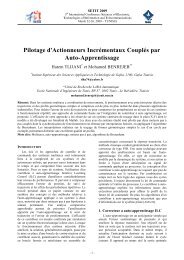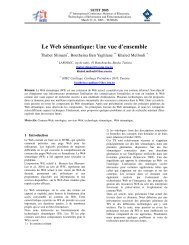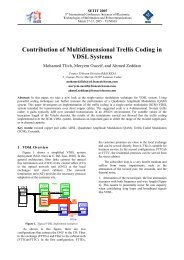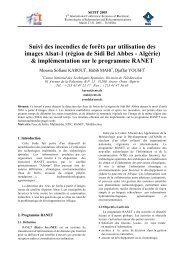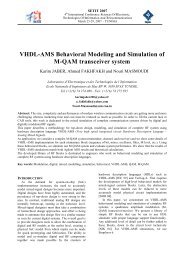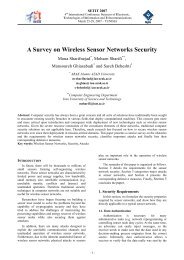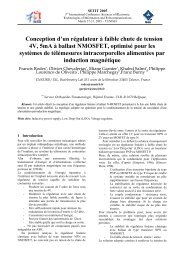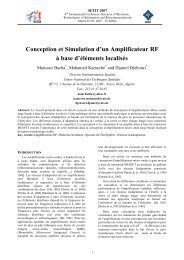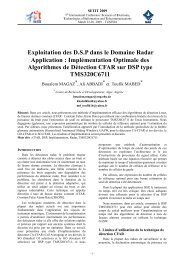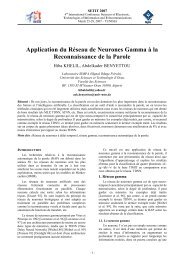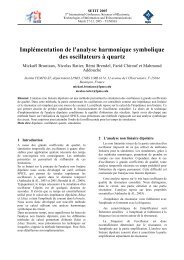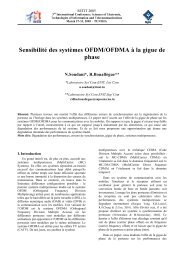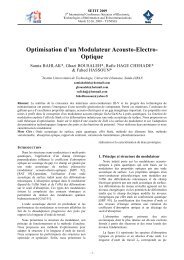Mobility Issues in Hierarchical Mobile IP
Mobility Issues in Hierarchical Mobile IP
Mobility Issues in Hierarchical Mobile IP
Create successful ePaper yourself
Turn your PDF publications into a flip-book with our unique Google optimized e-Paper software.
SETIT2005<br />
registered FA sends a pag<strong>in</strong>g request message to other<br />
FA <strong>in</strong> the same pag<strong>in</strong>g area as well as transmitt<strong>in</strong>g the<br />
message on its own network.<br />
The MN registers through the current FA to its HA<br />
when it receives the pag<strong>in</strong>g request. After the MN has<br />
received the registration request, it will then send a<br />
pag<strong>in</strong>g reply to its registered FA through its current<br />
FA. This is done to <strong>in</strong>form the registered FA of the<br />
MN current location. When the registered FA receives<br />
a pag<strong>in</strong>g reply, it forwards any buffered packets to the<br />
MN.<br />
For the comparison between HM<strong>IP</strong> and <strong>Mobile</strong> <strong>IP</strong>,<br />
the standard Network Simulator, ns, with the<br />
distribution version ns-all<strong>in</strong>one 2.1b6 was patched<br />
with a freely available ns wireless extension module.<br />
The wireless extension meant is Columbia <strong>IP</strong><br />
Micromobility Software (CIMS).<br />
2. Related Works<br />
In (Andrew & al 2003), it is mentioned that the<br />
primary role of micromobility protocols is to ensure<br />
that packets arriv<strong>in</strong>g from the Internet and addressed<br />
to mobile nodes are forwarded to the appropriate<br />
wireless access po<strong>in</strong>t <strong>in</strong> an efficient manner. It is also<br />
mentioned that to do this, micromobility protocols<br />
ma<strong>in</strong>ta<strong>in</strong> a location database that maps mobile node<br />
identifiers to location <strong>in</strong>formation. In this paper they<br />
stated that by us<strong>in</strong>g hierarchical protocol, it could<br />
reduce the disadvantages of <strong>Mobile</strong> <strong>IP</strong> protocol such<br />
as delay, packet loss and signal<strong>in</strong>g load. However the<br />
authors are more focused on compar<strong>in</strong>g only Cellular<br />
<strong>IP</strong> and HAWAII.<br />
Work <strong>in</strong> (Haver<strong>in</strong>en & al 2000) focuses on pag<strong>in</strong>g<br />
which is one of the ma<strong>in</strong> characteristics of<br />
<strong>Hierarchical</strong> <strong>Mobile</strong> <strong>IP</strong>. The pag<strong>in</strong>g extension that is<br />
used <strong>in</strong> HM<strong>IP</strong> allows idle mobile nodes to operate <strong>in</strong> a<br />
power sav<strong>in</strong>g mode while located with<strong>in</strong> a pag<strong>in</strong>g<br />
area. The location of mobile nodes is known by Home<br />
Agents (HA) and is represented by pag<strong>in</strong>g areas. After<br />
receiv<strong>in</strong>g a packet addressed to a mobile node located<br />
<strong>in</strong> a foreign network, the HA tunnels the packet to the<br />
pag<strong>in</strong>g FA, which then pages the mobile node to<br />
reestablish a path toward the current po<strong>in</strong>t-ofattachment.<br />
The pag<strong>in</strong>g system uses specific<br />
communication time slots <strong>in</strong> a pag<strong>in</strong>g area.<br />
In (Debal<strong>in</strong>a 2002) the author compares between<br />
the <strong>in</strong>ter-doma<strong>in</strong> mobility management and the <strong>in</strong>tradoma<strong>in</strong><br />
mobility management. The advantages stated<br />
by the author are first; the mobility of a node with<strong>in</strong> a<br />
doma<strong>in</strong> is fully transparent to its correspondent nodes.<br />
The second advantage stated is that when <strong>in</strong>ter-doma<strong>in</strong><br />
and <strong>in</strong>tra-doma<strong>in</strong> are differentiated, an architecture,<br />
which is hierarchical, scalable flexible and customize<br />
is provided. The paper proved that the mobility<br />
management signal<strong>in</strong>g load is reduced by 69%<br />
compared to <strong>Mobile</strong> <strong>IP</strong> us<strong>in</strong>g a hierarchical mobility<br />
management scheme. However full comparison<br />
between <strong>Hierarchical</strong> <strong>Mobile</strong> <strong>IP</strong> and standard and<br />
<strong>Mobile</strong> <strong>IP</strong> is not given.<br />
3 Simulation Scenario<br />
3.1 Packet Loss<br />
The follow<strong>in</strong>g simulation scenarios are conducted<br />
us<strong>in</strong>g NS-2 simulator. The packet loss is obta<strong>in</strong>ed by<br />
us<strong>in</strong>g the formula:<br />
Number of Packet Loss =<br />
Number of Send Packet – Number of Received Packet<br />
In M<strong>IP</strong>, referr<strong>in</strong>g to Figure 3, start<strong>in</strong>g at t = 10sec,<br />
there is already packet loss. This packet loss is due to<br />
the signal<strong>in</strong>g overhead at the Internet, the registration<br />
process (B<strong>in</strong>d<strong>in</strong>g Update) between the MN and the<br />
HA and registration due to time out when the MN is <strong>in</strong><br />
the foreign network. Furthermore, <strong>in</strong> the simulation<br />
done, there are bandwidth limitations of 5Mbps and<br />
the queue limit is only up to 200 bytes. When the<br />
queue reached its limit, congestion occurs; this will<br />
lead to more packet loss.<br />
num ber of packet loss<br />
(x 10^4)<br />
1.400<br />
1.200<br />
1.000<br />
0.800<br />
0.600<br />
0.400<br />
0.200<br />
0.000<br />
NUMBER OF PACKET LOSSES<br />
HM<strong>IP</strong> packets<br />
M<strong>IP</strong> packets<br />
0 10 20 30 40 50 60 70 80 90 100<br />
simulation time (sec)<br />
Figure 3. Comparison of Packet Losses<br />
In HM<strong>IP</strong>, at t = 5sec, it starts to loss packets because<br />
of the registration request and reply between MN,<br />
GFA and HA. Then the packets loss <strong>in</strong>creases<br />
gradually because of the regional tunnel<strong>in</strong>g <strong>in</strong> the GF<br />
Network. The process of encapsulation and<br />
decapsulation of packets by the FAs also <strong>in</strong>creases the<br />
loss. This shows that <strong>in</strong> micromobility, HM<strong>IP</strong> is better<br />
than M<strong>IP</strong> <strong>in</strong> terms of packet loss.<br />
3.2 Delay<br />
From the graph, for M<strong>IP</strong> the delay starts at 4ms<br />
and it <strong>in</strong>creases and decreases <strong>in</strong>consistently. The<br />
delay is caused by the congestion of traffic and the<br />
queue size limitation that is set. The packets will be<br />
buffered before be<strong>in</strong>g forwarded. The delay <strong>in</strong>creases<br />
and decreases <strong>in</strong>consistently because of the<br />
registration to the HA through the Internet frequently.


